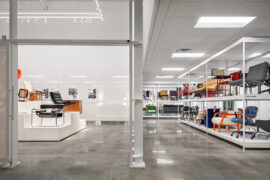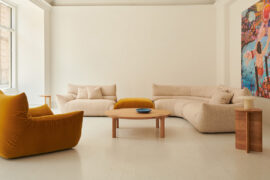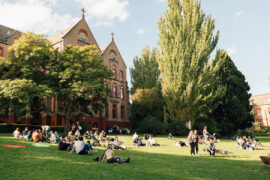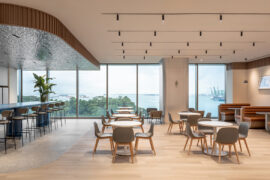We caught up with Jaime Hayon at Palazzo Serbelloni in Milan, where Caesarstone unveiled his latest wonderland: a fun take on the idea of the pavilion with a Hayon-esque dose of eccentricity.
Things have gotten a little crazy in the ballroom at Palazzo Serbelloni – the late eighteenth-century palace in Corso Venezia, Milan. And we mean that in an entirely good way! Caesarstone has continued its Designer Collaboration Programme (which last year saw Tom Dixon create a series of experimental kitchens inside a deconsecrated church), and this year Jaime Hayon has turned up the fun factor with a kaleidoscopic pavilion that mixes references and upturns expectations of enquineered quartz.
Stone Age Folk is the pinnacle event of the brand’s year-long collaboration with Hayon. Earlier this year we reported on his series of furniture that used Caesarstone in a type of punchy new-age marquetry: cabinets with faces, bird-shaped tables and more. This concept takes a more architectural form in Milan, where the same set of inspirations (flora, fauna and folklore from various cultures) has manifested in a walk-in riot of shapes, patterns and colours.
“I tried to reinvent marquetry with my aesthetic,” Hayon told us. “I thought the challenge here was to raise the voice of the Caesarstone material – to make it stand out more. It’s a twenty-first-century type of stone and when you assemble it together and make marquetry, you can create something really special,” he said.
The pavilion, which has a hand-assembled metal structure, incorporates 48 Caesarstone colours as well as coloured glass that casts graphic shadows onto the palace walls. Tribal masks and clown faces appear at a large scale in wall panels, alongside spinning carousels made with Caesarstone, and other furniture pieces.
“This is an installation that started a long time ago in my brain – this idea of making a pavilion. Once in a while a case study, a pavilion, or a special ephemeral architectural element comes into place within the history of design and architecture, in a universal expo for example. There have been a lot of examples – from Josef Hoffmann’s Austrian pavilion to the Crystal Palace to case studies by the Eameses and Le Corbusier.”
He continues, “I just wasn’t sure what materials would work. I wanted to make something a little bit wild. Things clicked when I met Caesarstone and it became a great opportunity. What I always try to find, especially now at this moment in my career, is people who want to do something that will push the limits.”
What does he hope people who visit the pavilion will take away from the experience? “I already saw it just now – exactly what I want people to feel. ‘Wah? What’s that?’ This effect of being surprised. Design today is not only about creating functional stuff. It’s also about being surprised, and challenging the material and challenging the creativity.”
INDESIGN is on instagram
Follow @indesignlive
A searchable and comprehensive guide for specifying leading products and their suppliers
Keep up to date with the latest and greatest from our industry BFF's!

The undeniable thread connecting Herman Miller and Knoll’s design legacies across the decades now finds its profound physical embodiment at MillerKnoll’s new Design Yard Archives.

A curated exhibition in Frederiksstaden captures the spirit of Australian design

For Aidan Mawhinney, the secret ingredient to Living Edge’s success “comes down to people, product and place.” As the brand celebrates a significant 25-year milestone, it’s that commitment to authentic, sustainable design – and the people behind it all – that continues to anchor its legacy.
The new range features slabs with warm, earthy palettes that lend a sense of organic luxury to every space.

International design superstar Jaime Hayon met us at the Wittmann showroom during Milan Design Week 2025 to talk us through his new KOLINAS sofa collection.
The internet never sleeps! Here's the stuff you might have missed

Abbotsford Convent has appointed Kennedy Nolan to guide the next stage of development at the heritage-listed Melbourne precinct, continuing its evolution as a cultural and community landmark.

Bean Buro’s Singapore office for Anglo-Eastern is a poetic continuation of their Hong Kong headquarters — a workplace that balances identity and calm.